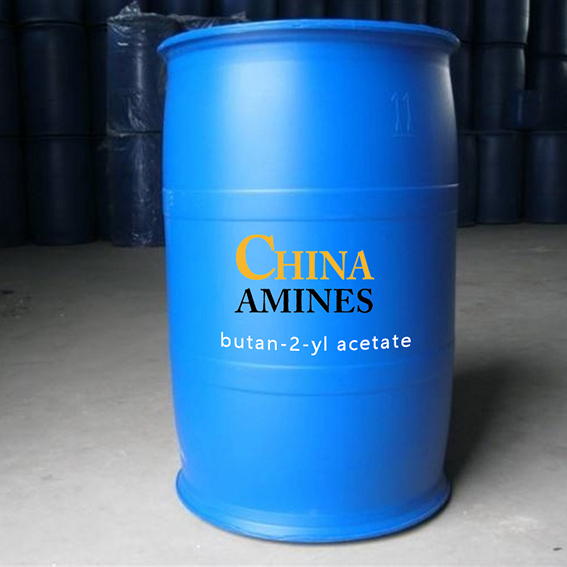1. Chemical Structure and Properties
Molecular Formula: C₆H₁₂O₂
Structural Formula:
CH₃COOCH(CH₂CH₃)₂
A branched acetate ester derived from the esterification of acetic acid with sec-butanol.
Physical Properties:
Appearance: Clear, colorless liquid with a fruity, pear-like odor.
Boiling Point: 112–115°C; Density: 0.86–0.88 g/cm³; Vapor Pressure: 15 mmHg at 20°C.
Solubility: Immiscible with water; fully miscible with alcohols, ethers, and hydrocarbons.
Chemical Properties:
Hydrolysis Stability: Stable under neutral conditions; hydrolyzes in strong acids/bases to acetic acid and sec-butanol.
Thermal Stability: Decomposes above 200°C, releasing ketones and CO₂.
Flammability: Flammable (flash point: 22°C; autoignition temperature: 420°C).
2. Industrial Applications
Coatings & Inks:
High-Performance Solvent: Used in automotive coatings, wood lacquers, and printing inks for rapid evaporation and low residue.
Adhesives:
Plasticizer: Enhances flexibility in rubber-based adhesives and sealants.
Flavors & Fragrances:
Food & Cosmetic Additive: Imparts fruity notes in food flavorings (e.g., artificial pear) and perfumes.
Electronics:
Cleaning Agent: Removes fluxes and oils from circuit boards without damaging components.
3. Safety and Toxicology
Acute Exposure:
Inhalation (≥500 ppm): Irritates respiratory tract; causes dizziness (TLV-TWA: 200 ppm).
Skin Contact: Mild irritation (rabbit skin LD₅₀: >5,000 mg/kg); negligible absorption.
Ingestion: Low toxicity (oral LD₅₀ rat: >5,000 mg/kg); gastrointestinal discomfort.
Chronic Effects:
Carcinogenicity: Not classified by IARC or NTP; no evidence of mutagenicity (Ames test negative).
Reproductive Toxicity: No teratogenicity observed in OECD 414 studies.
Protection Measures:
PPE: Nitrile gloves, vapor respirators, and explosion-proof ventilation.
Storage: Store in flame-resistant containers away from oxidizers and ignition sources.
4. Environmental and Regulatory Compliance
Environmental Impact:
Biodegradability: Rapid (OECD 301F: >90% degradation in 28 days).
Aquatic Toxicity: LC₅₀ (fish, 96h): 50–100 mg/L; EC₅₀ (daphnia, 48h): 30–60 mg/L.
VOC Status: Classified as a volatile organic compound (VOC) under EU and US regulations.
Regulatory Frameworks:
EU:
REACH: Registered (EC 210-946-8); CLP classified as Flam. Liq. 2 (H225).
USA:
EPA: Regulated under TSCA; listed as a VOC under Clean Air Act.
OSHA: PEL: 200 ppm (8-hour TWA).
China:
GB 13690-2009: Classified as Hazardous Chemical (Class 3.2).
Waste Management:
Incinerate in licensed facilities with VOC abatement; landfill disposal prohibited.
5. Case Studies and Application Insights
Case 1: Low-VOC Automotive Coatings (AkzoNobel, 2023):
Challenge: Reduce VOC emissions in spray paints without compromising drying speed.
Solution: Replaced 25% of toluene with sec-butyl acetate.
Result: Achieved 30% lower VOC emissions (ASTM D6886) and maintained gloss retention (ASTM D523).
Case 2: Sustainable Flavors (Givaudan, 2022):
Process: Used sec-butyl acetate in bio-based fruit flavor formulations.
Impact: Met EU Food Grade (EC 1334/2008) standards and reduced synthetic additives by 20%.
Comparative Analysis:
sec-Butyl Acetate vs. n-Butyl Acetate:
Pros: Faster evaporation; lower toxicity (higher LD₅₀).
Cons: Higher flammability (flash point 22°C vs. 22°C).
sec-Butyl Acetate vs. Ethyl Acetate:
Pros: Better solvency for hydrophobic resins; less hygroscopic.
Cons: Higher cost and regulatory restrictions.
Specifications:
Butanone, also known as methyl ethyl ketone (MEK) or ethyl methyl ketone, is an organic compound with the formula CH3C(O)CH2CH3. This colorless liquid ketone has a sharp, sweet odor reminiscent of acetone. It is produced industrially on a large scale, but occurs in nature only in trace amounts. It is partially soluble in water, and is commonly used as an industrial solvent. It is an isomer of another solvent, tetrahydrofuran.


